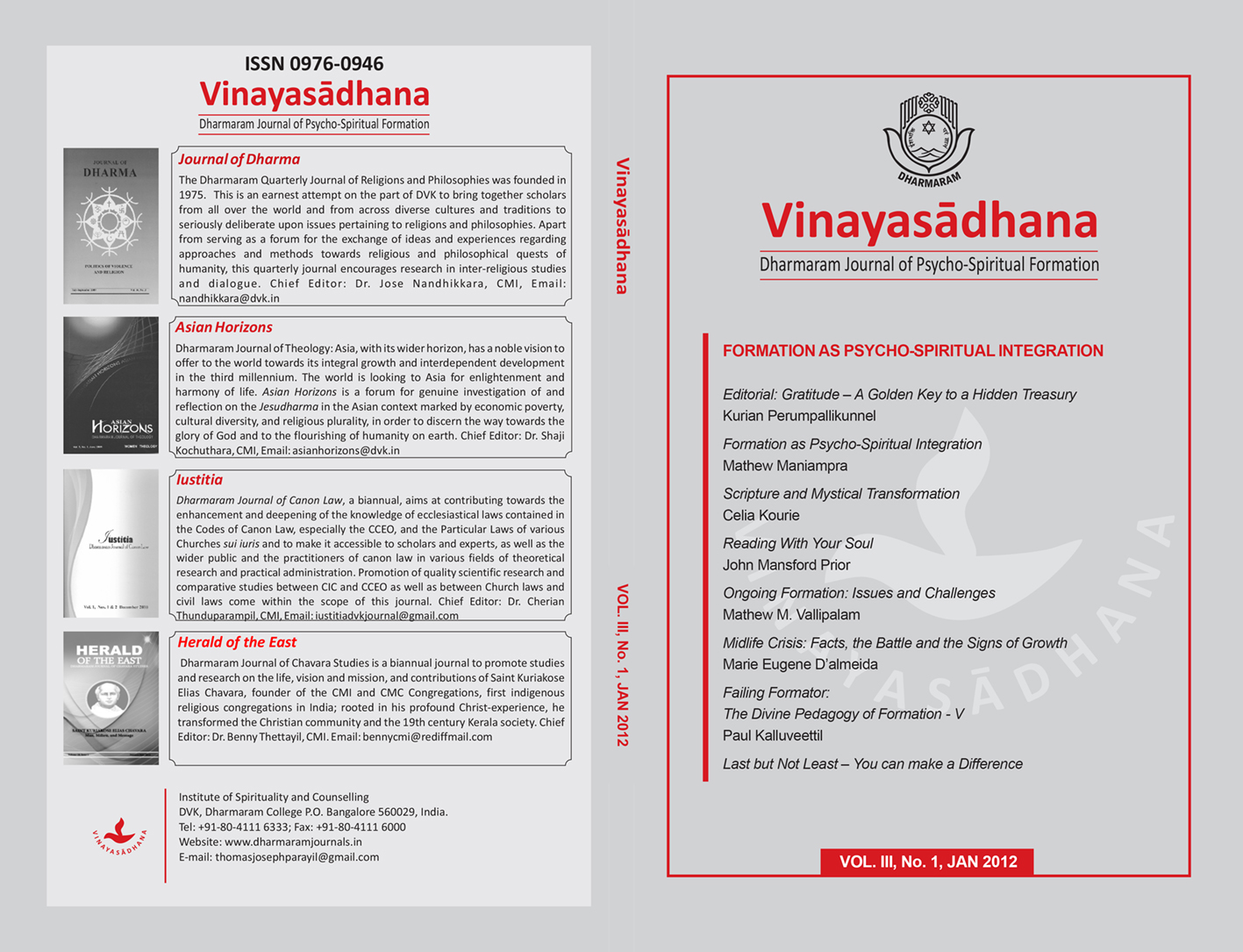ONGOING FORMATION
ISSUES AND CHALLENGES
Keywords:
ONGOING FORMATION, Vita ConsecrataAbstract
Continued growth and development is natural to any human being in any walk of life. For priests and religious, ongoing formation is an integral renewal process, envisaging a continuous progression towards realizing their full potential. This entails a personal as well as a community commitment to a continuous renewal of fidelity to the founder. There is no specific age at which a person can consider that they have achieved full maturity in priestly or religious life. One should try to improve the quality of one’s response to the commitments of ordained life.
Ongoing formation must be systematic, comprehensive and geared to the individual’s spiritual, apostolic, doctrinal and practical needs. Continuing formation after ordination enables the priest to retain relevancy, both within developing times and new pastoral challenges. Vita Consecrata, the post-synodal apostolic exhortation, mentions five stages of ongoing formation: the critical stage, the risk of routine, the stage of maturity, advanced age and completion of formation at the moment of death.
References
Catholic Bishops Conference of India, (2011) “Globalization and Justice in India” (Leaflet), CBCI Office, New Delhi.
CBCI Evaluation Report, (1995) CBCI Evaluation Committee, New Delhi. 84.
Charter of Priestly Formation for India, (3rd print), (2007) (Revised on the basis of the apostolic visitation) CCBI Centre, Bangalore No.37
Code of Canon Law, No. 661
Coughlin, Edward (1988) “Mutual Challenges: Initial and Ongoing Formation”, Review for Religious 47 No.6, 874-875
Directives on Formation in Religious Institutes, (1990) Congregation of Clergy and Religious, Rome, No.67
Directives on the Formation of Seminarians Concerning Problems Related to Marriage and the Family, (1995) Vatican City, No.60
Ecclesiae Sanctae II, 19
John Paul II, Pope (1990) “Closing Address to the Synod”, Origins 20. 378-379
Marcial, Marciel, L.C. (1992) Integral Formation of Catholic Priests, Alba house, New York, Society of St. Paul, 57
Mauro Jöhri, “Get Up and Walk,” Circular Letter, Curia Generalis Fratrum Minorum Capuccinorum, Rome, 2010
Molinary, Paul (1981), (Interview - A.R.C. Program), “Religious Formation as It looks Today”, Human Development-1, 58-64
Monteiro, Evelyn (2001) “Challenges of the Church in India in the 3rd Millennium.” Ephrem’s Theological Journal 5, 82-89
Mundaden, Kuriakose (ed.), (2009) Vazhithettiya Viswasam (Malayalam) (Distorted Faith) S. H. League, Alwaye, 290-292
Optatam Totius, No. 2.
Oriental Code Canon Law, No. 372.1
Pastores Dabo Vobis, No. 70
Paul VI, Pope (1971) “On the Renewal of religious Life According to the Teaching of the Second Vatican Council”, Apostolic Exhortation, No.71
Puthumana, Abraham (1985) “Ongoing Formation of Religious,” In Christo 23No. 3.127
Statistical Report of Religious in India, (2010) Religious India, No.31, 1.
Statistical Yearbook of the Church (2007) Vatican City, 39, 97.
Synod of Bishop’s Special Assembly for Africa, (1993), Vatican City, No. 27.
The Basic Plan for Priestly Formation (1970), Sacred Congregation for Catholic Education, No.10
The Charter of Priestly Formation in the Syro-Malabar Church (2007), The Syro-Malabar Major Archepiscopal Commission for Clergy and Institutes of the Consecrated Life, Mount St. Thomas, Kochi, 116-119
The Divine Shepherds Voice 2 (2004)123
Vallipalam, Mathew M. (1992) “Recruiting Vocations to Religious life”, Asian Quest 6, 39-39
Vallipalam, Mathew M. (2007) “Challenges of Initial Formation”, Sanyasa - Journal of Consecrated Life 2,132-137
Vallipalam, Mathew M. (2004) “The Ongoing Formation of Priests: Its Relevance to Their Fruitful Ministry,” The Divine Shepherds Voice 2.123
Vita Consecrata, No. 70


